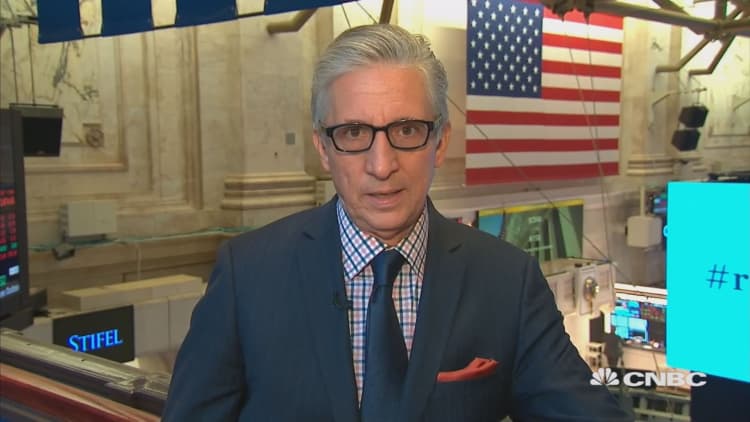
Corporate debt in the U.S. is now higher than it's ever been.
This is typically manageable if companies have a lot of cash to service that debt. But a looming problem, many economists are warning, is that — excluding the country's biggest companies — debt-to-cash ratio is now higher than it was in 2008 during the financial crisis.
Ten years on from the crash of Lehman Brothers that heralded the Great Recession, market watchers are looking for clues as to where the root of the next crisis might lie. Steve Blitz, chief U.S. economist at TS Lombard, sees a giant red flag in corporations' debt versus their means to pay that debt off.
"The real biggest problem lies, if I'm looking at the U.S., I look at debt-to-cash ratios, and I take out the top ten companies," Blitz told CNBC's Squawk Box Europe on Wednesday, noting his exclusion of highly capitalized companies like major tech and pharmaceutical firms who are well-stocked to service their debts.
"Debt to cash is very very high, but debt equity is very very low. What that tells me is corporations are borrowing against their net worth, as opposed to borrowing against cash flow and income, which in effect is the same thing households were doing in 2004, 2005 and 2006."
S&P Global reported U.S. corporate debt at a massive $6.3 trillion in June, with companies also holding a record $2.1 trillion in cash to service that debt. But most of that cash is held by a handful of giants at the top.
Meanwhile, riskier borrowers are more leveraged than ever before.
The cash-to-debt ratio of speculative-grade borrowers reached a record low of 12 percent in 2017, below the 14 percent level in 2008 — meaning that for every dollar they have in cash, they have $8 of debt.

That's been fueled by the fact that businesses have been borrowing increasing amounts under extremely accommodative conditions in a low-interest environment since the last crash — without effectively improving their liquidity profiles.
"So as a result what you have is the risk that if the equity market comes down a lot, if you get a bear market for whatever reason — and one is going to show up eventually, it always does — when that does occur… It's like that old story. When the tide goes out, the rocks show up."
A 'moral hazard'
The International Monetary Fund (IMF) has similarly highlighted this threat, warning that riskier lending behavior could lead to another crash.
"A period of high credit growth is more likely to be followed by a severe downturn or financial sector stress over the medium term if it is accompanied by an increase in the riskiness of credit allocation," the IMF said in its Global Financial Stability Report in April.
Global debt, meanwhile, is a record $247 trillion — that's 318 percent debt to gross domestic product, far above the level in 2007 and 2008, the Institute of International Finance (IIF) reported in July.
This could spell trouble as interest rates rise, particularly if they trigger a pullback in equities — something that is inevitable, Blitz warned. And with banks now taking less risks than they did a decade ago due to post-crisis regulations, the liquidity in the market is gone, he added. So the question is, when everyone starts selling, who's on the buy side?
In fixed income markets, it's the Fed. Asked if the Fed could step in to buy equities during a crisis, Blitz replied, "you'd hate to see that happen." This is because it would present what the economist called a "moral hazard."
"The more the government is involved in markets and market making, you always raise the issue of moral hazard because then people will take more risk believing they'll always get bailed out."
Other analysts say that the red flags aren't appearing yet, mostly thanks to low interest rates and high economic growth, and the fact that it's the well-capitalized, large-cap companies that mainly drive equities. Still, as quantitative tightening progresses and other potential selloff triggers loom on the horizon, like emerging market worries and trade war fears, these unprecedented debt levels may look more vulnerable than ever — begging the question of how much we've really learned in the past ten years.


